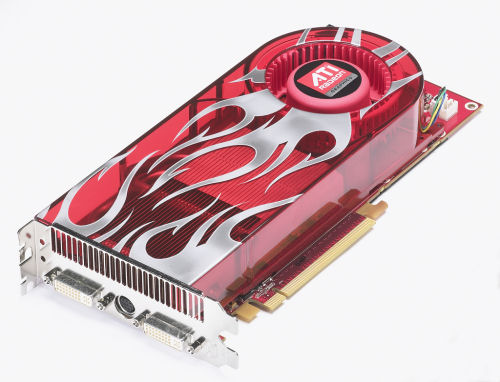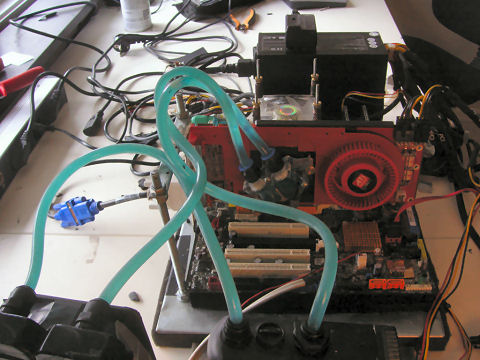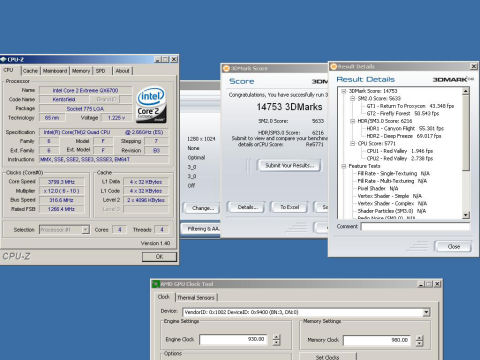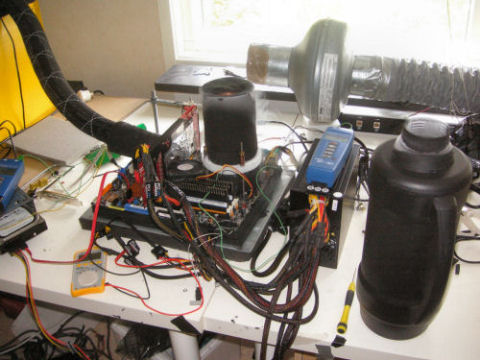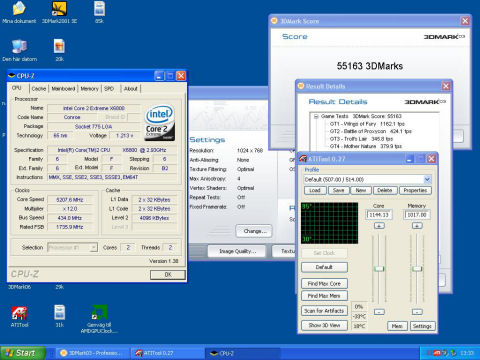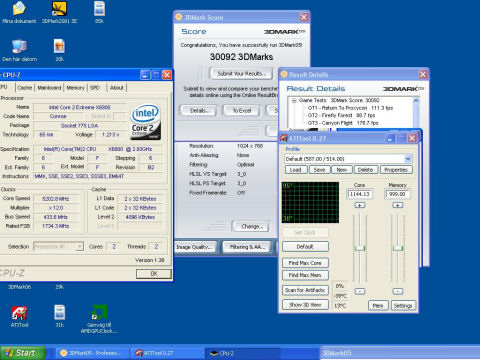It’s taken longer than expected for AMD to release its first DirectX 10-based circuit, but now it has arrived and we decided to see what the circuit has to offer for the enthusiast in our first article about R600.
ATI has finally launched its highly anticipated graphics circuit R600 and the graphics card series Radeon HD 2900. There has been an almost unbearable wait for many, not the least those who are eager to overclock the new circuit. Someone told us that records are meant to be broken and that is what we’re going for in this overclocking article starring ATI’s new graphics card.
Unlike the NVIDIA G80 architecture, it’s been known for long that ATI is working on a DirectX 10 circuit based on a Unified Shader architecture. ATI designed Xenos for Microsoft and its next generation video game console Xbox 360 and there was no doubt that the next circuit would be even faster.
We will publish a full scale review of the HD 2900 XT up ahead, but already as of today we can present a lot of goodies for those who want to see some overclocking. Marcus has been resting the last couple of months, but now he’s back; bigger, stronger and more beautiful than ever.
The cooler of ASUS AMD ATI Radeon HD 2900XT is brand new. It’s made entirely from copper and has two sturdy heatpipes for spreading the heat efficiently to all surfaces. The entire cooling profile is housed inside a plastic cover that concentrates the air flow through the cooler and releases the hot air outside of the case. The radial fan is the same kind used by NVIDIA and the 8800 series. Unlike the cooler of the 8800 series the cooler profile of the GPU and the memories are not the same, but separate. Completely understandable as the card has BGA chips on both sides of the circuit board.
The power supply of the card is cooled by the same heatspreader that cools the memories. A big, red piece of aluminum. The memory chips on the back are cooled by a lighter piece of aluminum also painted red.
The mounting holes are identical to the previous generation, which makes it a lot easier to cool the card with third-party coolers, such as water blocks, phase change cooling or container for liquid nitrogen and dry ice.
There’s a small problem with third-party coolers though, the edge around the core is slightly higher than the core itself. We tried mounting water blocks, cascade and liquid nitrogen containers and the contact is satisfactory. It’s not optimal so we recommend you to use blocks specifically designed for R600, which should appear soon, or make your own coldplate to fill the void. One cheap and convenient solution could be to locate an old CPU cooler using thin aluminum or copper fins. You can see what we mean on the picture below.
|
Tools & material
|
Result
|
|
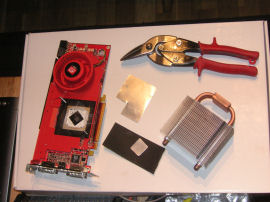 |
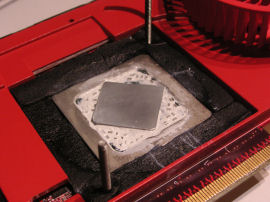 |
The one thing that has probably caused the most discussion with the HD 2900XT is the 8-pin PCI-E connector for additional power. The only purpose of this connector is to deliver more stable voltages and, of course, more power when overclocking. You can do without and the fact is, that our tests were done with two 6-pin connectors. You don’t have to buy a power supply with an 8-pin connector to overclock HD 2900XT.
|
Radeon HD 2900XT
|
GeForce 8800GTS 640MB
|
|
 |
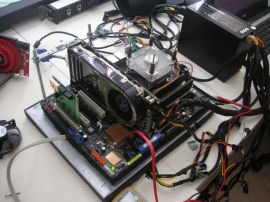 |
|
|
GeForce 8800 GTX
|
GeForce 8800 Ultra
|
|
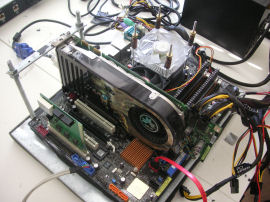 |
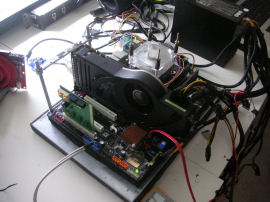 |
|
|
Water cooling
|
Compressor cascade
|
|
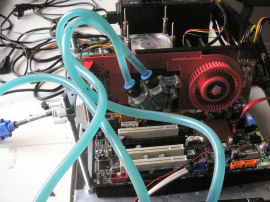 |
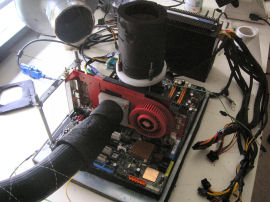 |
Test system | |
| Hardware | |
| Motherboard | ASUS P5W DH |
| Processor | Intel Core 2 Extreme X6800 |
| Memory | Corsair Dominator PC8888 2x1024MB |
| Harddrive | WD Raptor 36GB 10 000 RPM |
| Monitor | Dell UltraSharp 2405FPW |
| Graphics cards | ASUS GeForce 8800GTS 640MB ASUS GeForce 8800GTX 768MB ASUS GeForce 8800Ultra 768MB ASUS Radeon HD 2900XT 512MB |
| Power supply | Silverstone 850W |
| Software | |
| Operating system | Windows XP (SP2) |
| Drivers | Catalyst 8.37 ForceWare 158 |
| Benchmarks |
3DMark 01SE |
We continue our overclocking article by looking at how R600 and G80 performs in 3DMark.
We have to say that we expected more of 2900XT in 3DMark 01. The truth is, that score is actually very good, and the reason the 8800 GTX and Ultra perform better is that G80 is simply very good in nature. 829fps with the stock cooler without voltmods is just crazy.
|
Radeon HD 2900XT – 67463 points
|
GeForce 8800GTS 640MB – 64126 points
|
|
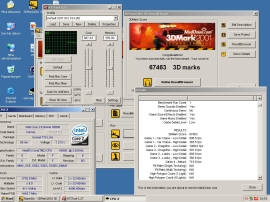 |
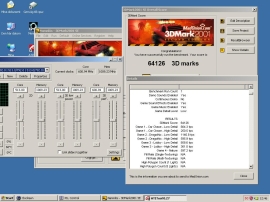 |
|
|
GeForce 8800GTX – 69717 points
|
GeForce 8800 Ultra – 70961 points
|
|
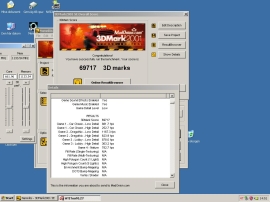 |
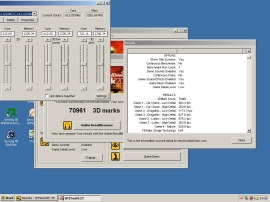 |
3DMark 03 on the next page.
3DMark 03 has been a real weakness with ATI’s circuits in the past. R520 and R580 was left far behind by G70, G71 and G80. R600 is the trend breaker and we can see some real potential for R600 in 3DMark 03.
|
Radeon HD 2900XT -45646 points
|
GeForce 8800GTS 640MB – 38355 points
|
|
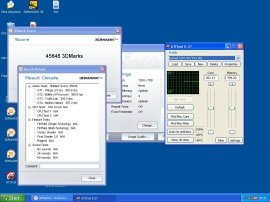 |
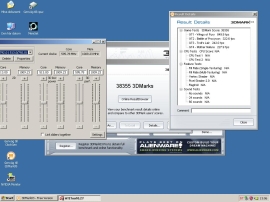 |
|
|
GeForce 8800GTX -47883 points
|
GeForce 8800 Ultra – 50451 points
|
|
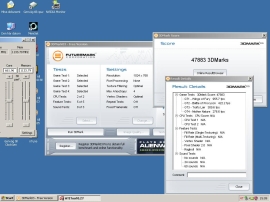 |
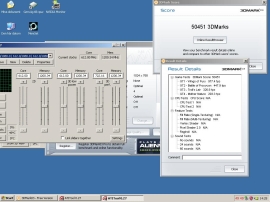 |
Let’s move on to 3DMark 05.
As expected, ASUS HD 2900XT is very strong in 3DMark 05. In Game Test 3 it obliterates 8800.
|
Radeon HD 2900XT – 22986 points
|
GeForce 8800GTS 640MB – 19162 points
|
|
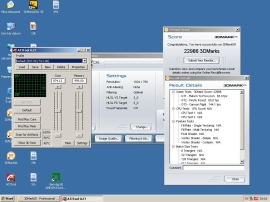 |
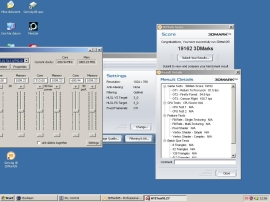 |
|
|
GeForce 8800GTX – 21452 points
|
GeForce 8800 Ultra – 22029 points
|
|
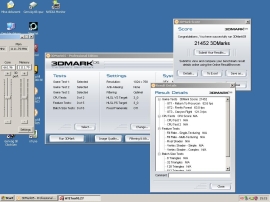 |
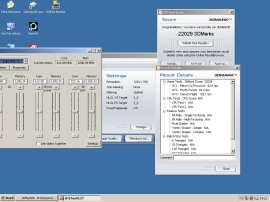 |
Last, but not least we have 3DMark 06.
ASUS HD 2900XT beats GTS by 2000 points and is very close to GTX and Ultra. It’s interesting to see that just like the R520 and R580, R600 is relatively strong in SM3.0. Someone told us that a new driver is on the way and will bring a big boost for the 2900XT; there is plenty of potential for 2900XT in 3DMark 06.
|
Radeon HD 2900XT – 13040 points
|
GeForce 8800GTS 640MB -11007 points
|
|
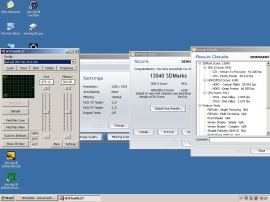 |
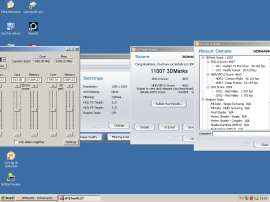 |
|
|
GeForce 8800GTX – 13315 points
|
GeForce 8800 Ultra – 13650 points
|
|
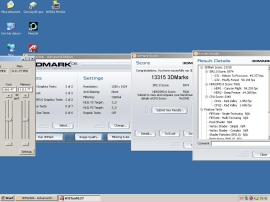 |
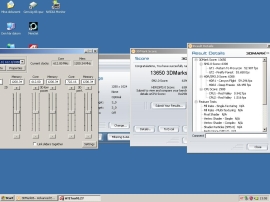 |
We move on and overclock ASUS HD2900XT using water cooling.
You can’t have missed all the discussions about R600 being a real hottie. This is mainly due to the big leakage of the 80nm process, a similar problem to that Intel had with Prescott. Personally, from an overclocking point of view, I like hot hardware because it means that there is a good margin for overclocking if you’re able to remove the heat. All of you who are using water cooling will love the ASUS HD 2900XT.
We haven’t performed any extensive testing with water cooling, but the picture below speaks for itself.
930MHz was reached with an Asetek Waterchill kit, which is far from the optimal water cooling for a graphics card, so you can expect even more if you’re using a more powerful water cooling system. Up from 874MHz with the stock cooler feels like a pretty good result.
On to the fun part.
Although it was pretty close, the thing we were looking forward to the most with ASUS HD 2900XT didn’t happen at all. We were expecting a delivery of liquid nitrogen last Thursday. Unfortunately something went wrong along the way and the nitrogen never reached its destination. When we found out about this it was already after 17:00 and there wasn’t much we could do about it at that moment, but as you know the longing for nitrogen can drive a man into doing almost anything. We had to do something.
The hunt for liquid cold
The reason I (Marcus) orders nitrogen to an AGA reseller is because I work as a ventilation technician and assembler 07:00-16:00 and all AGA depots close at 16:00 and is at least 1 hour and 15 minutes away. I knew that I couldn’t take the day off since we had a lot to do deadlines all over the place. It struck me that I could work 05:00-14:00 instead and in that way be able to pick up some nitrogen. The closest AGA depot is in Gothenburg and I was there a few years ago. Those who know me or have been visiting NordicHardware for a while know that I have no sense of direction, none what so ever. I’ve been there, but am still hesitant to leave because I have no recollection of where it is. I laugh when I read what I just wrote, but cries inside at the same time; it’s spooky how lost one can be.
Anyway, It all ends with me deciding to travel south down to Lund, which is almost twice the distance and visit the cryolab at Lund University. I’ve been there so many times I can find my way in my sleep. All the way down I keep an inner dialog running about why I am doing this. I wake up two hours earlier than usual, skips breaks to be able to quit even earlier. I reckon it’s worth it because if I do something wrong or make a wrong turn I have an extra buffer of an hour. When I arrive at the cryolab and am met by liquid nitrogen and helium things are starting to clear up for me, I know why I am doing this. When I start filling my cryo canisters I find myself with a big smile on my face. I truly love the sight of an empty canister chocked by the extremely cold nitrogen, it smokes and whines so damn nice. I have to admit that the last part is a bit extreme, but the reason I am typing this is to show you how little time there was before the NDA was lifted. And there is still a lot to do before we’re done. The coming weeks, and months, we will supply you with a never ending flood of overclocking and benchmarks here at NordicHardware, starring both 2900XT Crossfire and 8800Ultra SLI.
We plan to use liquid nitrogen to cool the processor and a compressor cascade with the ASUS HD 2900XT card. Even before we try the cascade with the graphics card, our experiences from the air and water cooling sessions we know that it will be working hard, harder than it has ever worked before. But then again you have to start somewhere, so why not be methodical and save some nitrogen.
|
Step 1
|
Step 2
|
|
 |
 |
|
|
Step 3
|
Step 4
|
|
 |
 |
|
|
Step 5
|
Step 6
|
|
 |
 |
|
|
Step 7
|
Step 8
|
|
 |
 |
|
|
Step 9
|
Step 10
|
|
 |
 |
After hours of preparations it’s time to start up the system.
There is no better feeling than when you’ve started the system, checked that everything is in order and you can start playing. We reached the conclusion that about 1150MHz on the core was the best we could do with this cascade, which in turn is on the verge of compressing its last gas. We reached this frequency at 1.45V. We were able to reach 1200MHz at 1.5V in one test, so there is definitely more to get.
We start with 3DMark 03, the Achilles heel of the R520 and R580, which we earlier showed you that this is not the case anymore. NVIDIA’s new driver and Ultra is a fatal combination in 03, but ASUS HD 2900XT is not that far behind. We start with 55,163 points in 3DMark 03.
R520, R580 and the R600 are the favorites when it comes to 3DMark 05. After half a day of sweating and tearing our hair we finally reached 30,000 points in 05. A new world record, with by about 400 points margin to K|ngp|n’s previous world record.
We promise you this; this is just the beginning…
Asus AMD ATI Radeon HD 2900XT is a card that all overclockers will love, but let’s remind you what we’ve been through with the X1800, X1900 and X1950 to really understand why. The frequencies of these cards were controlled through the drivers and software. Even the transition from 2D to 3D was handled by Catalyst. Problem-free if you didn’t overclock, adequate for when running a 24/7 overclocked system, anything but pleasant for the enthusiast and session overclocker. The problems for the enthusiasts were the worst as we mentioned and we needed a hero to solve this. The savior for all enthusiasts out there, not to mention ATI’s savior in order to become a part of the enthusiast and overclocking market became the overclocking tool called ATItool created by W1zzard. The problems with handling cool temperatures were still there though, only a few samples of the R520/R580 performed well when the temperatures dropped.
In contrast to its predecessor the ASUS AMD ATI Radeon HD 2900XT uses a hardware-level clock generator, also the transition from 2D to 3D is now entirely done hardware wise. By what we’ve seen so far this solves all of the problems that we find on the baby brother, and as we clearly saw during the cascade and nitrogen tests, the R600 doesn’t have any issues with sub-zero centigrade temperatures. What we wait for now is a full version of ATItool for R600 which should be available relatively soon. Worth mentioning is that ATItool for R600 will have the same functions as for the R520 and R580, namely overclocking, voltage control, fan control, sub-zero temperature monitoring and additional driver settings.
During our testing ATI has updated the drivers continuously and at each new revision we have noted significant performance boosts. We can only assume that the performance is going to increase, perhaps big boosts with the upcoming versions, but that remains to be seen in our next big review.
We hope you have appreciated our overclocking article and we hope it comes to use for you.
Last but certainly not least we want to thank ASUS for supplying us with a whole bunch of graphics cards.


















